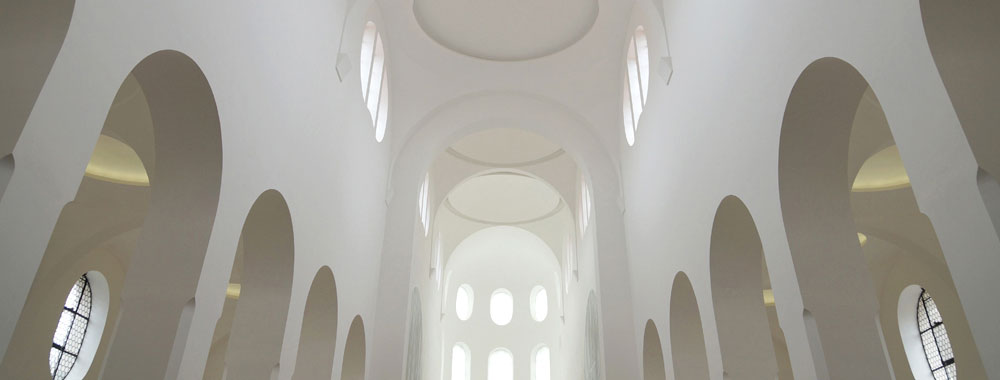Meditation in White: John Pawson's Conversion of St Moritz Church Augsburg

From exuberant Baroque to plain post-war charm – the interior of Augsburg's St Moritz Church has undergone a succession of transformations. The English minimalist John Pawson is responsible for yet a new chapter in its architectural history.
As far as the Catholic Church is concerned, it seems as though white is the most popular colour this spring: white symbolising omission, modesty, focussing on the essential. The new Pope Francis is fond of pure white, demonstrative of a church leader with a new attitude. A recently completed, rather unusual church building project is also resplendent in white: following a building period of two and a half years, St Moritz Church in Augsburg reopened at the end of April.
The story of St Moritz Church is a little reminiscent of Peter Zumthor's creation of the Bruder Klaus Field Chapel in Mechernich Wachendorf in the Eifel area: both are sacral buildings located in a provincial part of Germany that were built or, in this case, redeveloped by a world-renowned architect. The parish of Augsburg approached Pawson in 2007 and literally gave him "carte blanche" for conversion of the building. After having visited Novy Dvur in the Czech Republic before commencement of construction work in Augsburg, the parish councillors however already had a rough idea of what to expect. Back in 2004, Pawson created a monastery for a group of Trappist monks (a branch of the Order of Cistercians) who had moved from France to Novy Dvur – almost entirely in white, unadorned and free of detail, but with a unique atmosphere thanks to exquisite lighting design.
Instead of a new construction, this time Pawson proceeded with a radical intervention in a church building with 1,000 years of history. Starting off as a Romanesque basilica in 1019, St Moritz Church was rebuilt in the Gothic style in 1229. Master builder Johann Jakob Herkommer from Füssen subjected the building to a thorough Baroque transformation in 1714. The bombing on the 24th and 25th of February in 1944 only spared the outer walls, but the parish soon engaged a leading master builder of the time to rebuild the church. Dominikus Böhm gave the church interior a reduced, typically post-war aesthetic – a hint of what Pawson was to create later.
A series of further conversions in the course of the following decades began to smother the expressive Böhm design, causing the parish to take an unusual step in 2007. As part of a temporary art installation entitled "Void", the local artist Juliane Stiegele was commissioned to remove or cover all fixtures, fittings and furnishings visible in the church, which were not absolutely necessary for the liturgy, in favour of a kind of "visual fast".
A series of further conversions in the course of the following decades began to smother the expressive Böhm design, causing the parish to take an unusual step in 2007. As part of a temporary art installation entitled "Void", the local artist Juliane Stiegele was commissioned to remove or cover all fixtures, fittings and furnishings visible in the church, which were not absolutely necessary for the liturgy, in favour of a kind of "visual fast".
The wish to give this positive "fasting" experience a permanent setting led to the commissioning of John Pawson with the conversion of the church. Although traces of its Baroque history remain in the shapes of the windows, the spatial organisation and the carved figures of the apostles in the aisles, the atmosphere is completely different now. Dean Helmut Haug, who represented the parish in the conversion project, says that the white is also a challenge, emphasising that St Moritz Church is not a living room, or even a cosy church.
Only very few additional shades of colour on the border to colourlessness can be found. The floor is covered with light beige Portuguese limestone, which also constitutes the monolithic altar block weighing four and a half tons. The dark stained wood of the pews and choir stalls, as well as the edging of the organ above the entrance offers a sombre contrast. Apart from very few exceptions – such as the "Christ the Saviour" figure by the Baroque sculptor Georg Petel in the choir apse – there are no colour detractions even in the sparse sculptural decoration.
The finely veined, onyx panels laminated to glass that Pawson had fitted in front of the high choir windows are also almost white. They act as homogeneous light surfaces; only the outlines of the bars of the outer glazing are visible behind the translucent stone.
The sun rises a second time in St Moritz Church when it starts to get dark outside. Concealed LED lights fitted in the choir apse, at the bottom of the columns in the nave and in the calottes of the double-walled cupolas originating from Dominikus Böhm, fill the church with a slightly yellowish light.
Only one question remains: how does such an empty space sound? Visitors were able to gain a first impression at the opening concert on 28 April 2013 : while the acoustics are quite disastrous for the spoken word (the church builders of the past centuries knew why they liked to cover their pulpits), they are absolutely superb for plainsong.
